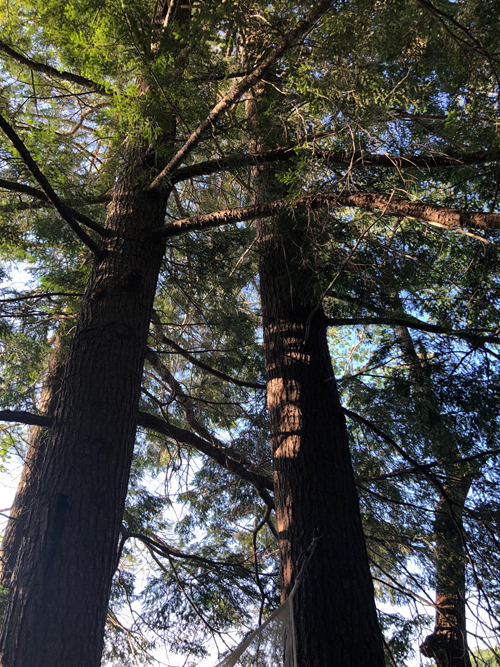Earth Notes: Can trees save us?

By Cynthia Stancioff
Guest Columnist
I might have been a Druid in a previous life.
Trees are to me, as they reportedly were to the Druids, sacred. I swear I can feel a life force when I am near a tree, and that antique trees (those over a hundred or so years old) have a special quality of energy around them. It’s this sort of feeling that has fed my hope that trees will magically help us in some profound way in our struggles with a warming climate.
• A hope that someone will figure out that the shade from a large tree cools such a volume of air, if we just planted enough shade trees and made it illegal to cut them down, maybe the cooler air everywhere would compensate for the warming?
• Or maybe that trees in a warming and more CO2-rich atmosphere will use up more carbon dioxide and outpace our increasing emissions?
• Perhaps the world will decide to halt deforestation and embark on massive afforestation, which will then cool the air and sequester the problematic carbon.
And we’ll all live happily ever after.
Well, to start, the shade thing isn’t what I thought it would be. While the shade of a large leafy tree does block the radiative warming of the ground beneath it and the re-radiating of surface heat back up at beings standing on it, the shaded air itself is usually only around 2 degrees cooler than the unshaded air. The highest estimate I have read for air-cooling from tree shade is about 9 degrees F under a whole grove of trees. Most of the cooling is from the evaporation of water from the leaves as they open their stomata (holes in their surface) to perform photosynthesis and cool themselves and therewith the surrounding air.
It’s a worthwhile thing, shade, and urban planners are beginning to emphasize shade in their urban space designs; but shade tree installation is certainly more of an “adaptation” tactic than a “warming solutions” tactic.
What about trees increasing their uptake and sequestration of CO2 as emissions and temperatures increase? Trees are indeed growing faster, with thicker leaves, and more leaves, due to these increases. Disturbingly, however, there is increasing evidence that competing responses within the tree complicate things.
True, photosynthesis and intake of CO2 both do increase, and photosynthesis becomes more efficient, requiring less water. This seems like good news for places that are getting drier. But actually, what happens is that the leaves emit less water vapor and exert less of the cooling effect. The phenomenon is so pronounced that they now think it might explain about 10% of the warming of the arctic (which is warming twice as fast as elsewhere), and perhaps 28% of the warming in the tropics.
Anyway, what about my third fantasy — a sudden resolve by the whole world to halt deforestation and go full tilt with afforestation? Well, I consulted an open-access user-friendly climate policy simulator from MIT called EnROADS to see what that would do.
The model performs thousands of calculations with continually updated data from all over the world to calculate the effects of policy choices on our current global warming trajectory for the end of the century (3.6 degrees C). I cranked up afforestation to the max and tamped down deforestation to the minimum. The result? Instead of 3.6 degrees C, we’ll get to a mere 3.4 degrees.
Add to this the very sad news that due to faster growth induced by the warmer, higher CO2 conditions, trees are now weaker, more fragile, and shorter-lived than they have ever been. It’s clear that antique wood has tighter grain and greater strength than modern wood, but this takes it to a new level. Combined with the brutally strong winds and micro-bursts we are experiencing increasingly, no wonder there are so many trees crashing down everywhere you look.
And when they die younger, they sequester carbon for less time.
I hate to say it, but it doesn’t look like the trees will save us. Nope, at this point, we have to worry about saving them, because as they suffer, they begin to inflict more suffering on the rest of the planet!
We all need to be thinking about bigways to improve our warming trajectory. To experiment with ways to fashion a climate policy strategy that has real impact, go to the EnROADS climate simulator and learn how to use it. They offer periodic trainings and online tutorials, and meanwhile you can just fool around with it. Try out your favorite policy idea or combination of ideas. https://en-roads.climateinteractive.org/scenario.html?v=21.7.1
Knowledge is power. The more we understand about this complex battle for the future, the better our chances of saving something for our descendants, and those of other species — like the trees.Cynthia Stancioff is a nature enthusiast from Chesterville, who spends her time writing, advocating, and lobbying for climate solutions, foraging for edible


